Plant Protection Today: USDA Safeguards Future Cherry Blossoms on the Capital’s Tidal Basin
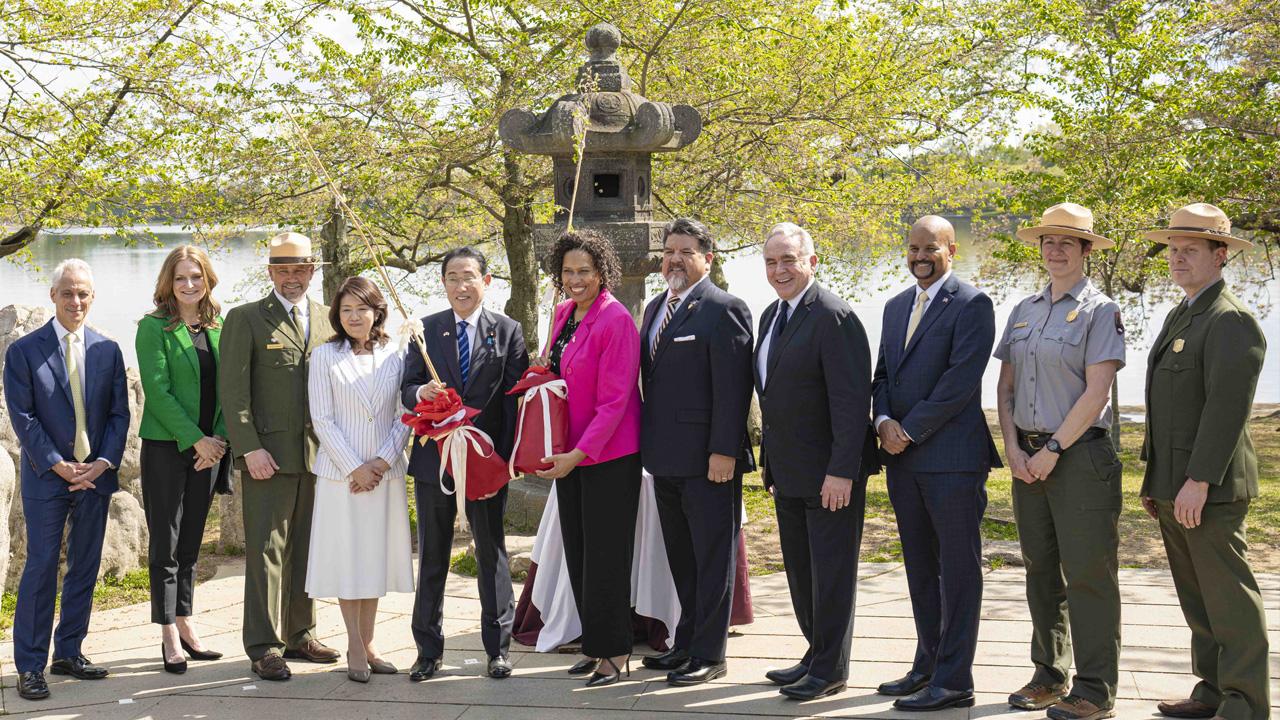
(Cover Photo: From left to right: United States Ambassador to Japan Rahm Emanuel; Trust for the National Mall President and CEO Catherine Townsend; National Mall and Memorial Parks Superintendent Jeff Reinbold; Yuko Kishida; Japanese Prime Minister Fumio Kishida; D.C. Mayor Muriel Bowser; National Park Service Director Charles F. Sams III; Deputy Secretary of State Kurt M. Campbell; Animal and Plant Health Inspection Service Administrator Michael Watson; National Mall and Memorial Parks Natural Resources Program Manager Leslie Frattaroli; and National Mall and Memorial Parks Service Landscape Architect Brian Flynn.]
Lessons Learned Forge a New Way Forward
By Sharon Lucik
Two young, thin cherry trees—each in decorative wrapping—carried tremendous symbolism during a diplomatic ceremony on April 10, 2024, at the Washington, DC, Tidal Basin. Japan’s Prime Minister Fumiko Kishida and First Lady Yuko Kishida presented them to the United States as a symbol of the two countries’ deep and lasting friendship. The trees also represented a future gift of 250 trees from Japan that will help replace more than 150 cherry trees that the U.S. National Park Service must remove as it repairs the Tidal Basin’s sea wall. Those 150 trees are all descendants of Japan’s original gift of thousands of cherry trees in 1912, which made the Tidal Basin a world-famous place of beauty and a tourist magnet. Administrator Mike Watson and Deputy Administrator Mark Davidson of USDA’s Animal and Plant Health Inspection Service (APHIS) attended the ceremony.
The cherry tree is iconic in Japanese culture. Today these trees are also a much-loved part of the area and annually celebrated during the Cherry Blossom Festival. However, looking back in history, the esteemed cherry tree had a precarious start:
Over 100 years ago, the mayor of Tokyo, Japan, learned that First Lady Helen Taft adored the delicate pink blossoms of Japanese cherry trees. He graciously offered to send 1,000 trees—which increased to 5,000—to Washington, DC, to beautify the city. Unfortunately, the first batch of 2,000 imported trees carried many exotic plant pests and diseases, and they were immediately burned.
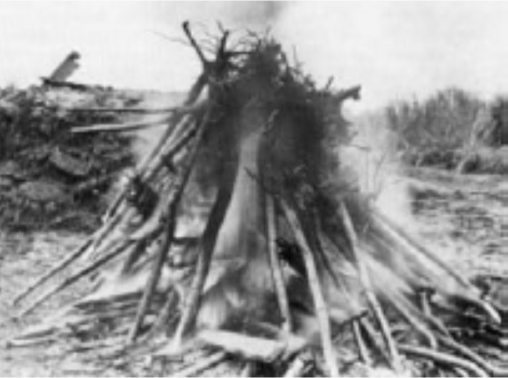
That unfortunate incident clearly elevated the need for plant health protection in the United States and Congress acted. In 1912, Congress passed the Plant Quarantine Act authorizing USDA to regulate imported nursery stock.
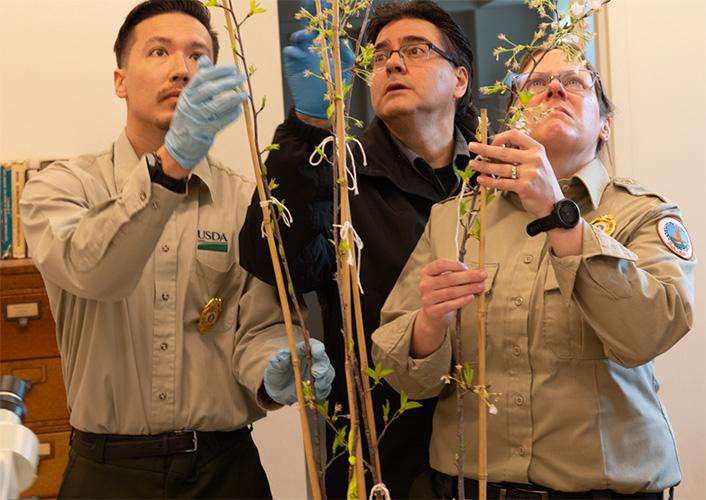
Our Past Informs Our Future Safeguards
Today, APHIS’ Plant Protection and Quarantine (PPQ) program has a system of safeguards in place to protect the country from harmful plant pests and diseases. This system is called the Safeguarding Continuum. All along the continuum, PPQ experts assess risks associated with hitchhiking plant pests and diseases.
“The process began when our APHIS’ International Services (IS) team in Japan received word that Prime Minister Kishida wanted to personally deliver the cherry trees. I worked with IS and our PPQ imports team to convey the U.S. import requirements and special permits needed for the cherry trees,” said PPQ’s Japan Trade Director Lisa Kohl. “IS and Japan’s Ministry of Agriculture, Forestry, and Fisheries officials did a fantastic job working together to ensure the trees were free from pests. At Japan’s Haneda Plant Protection Station, they visually inspected each tree, washed the root balls, confirmed no soil was present, replanted the trees in sterile peat moss, and packaged the trees in a pest-proof box for the flight.”
Fourteen hours after the plane left Japan, it arrived at Joint Base Andrews, and PPQ employees transported the cherry trees to its Beltsville, MD, plant inspection station. There, the trees were thoroughly inspected again, and staff confirmed they were pest- and disease-free. That gave Japanese Embassy officials the go-ahead to wrap the trees in red cloth—the color of good luck and good fortune—for the official ceremony.
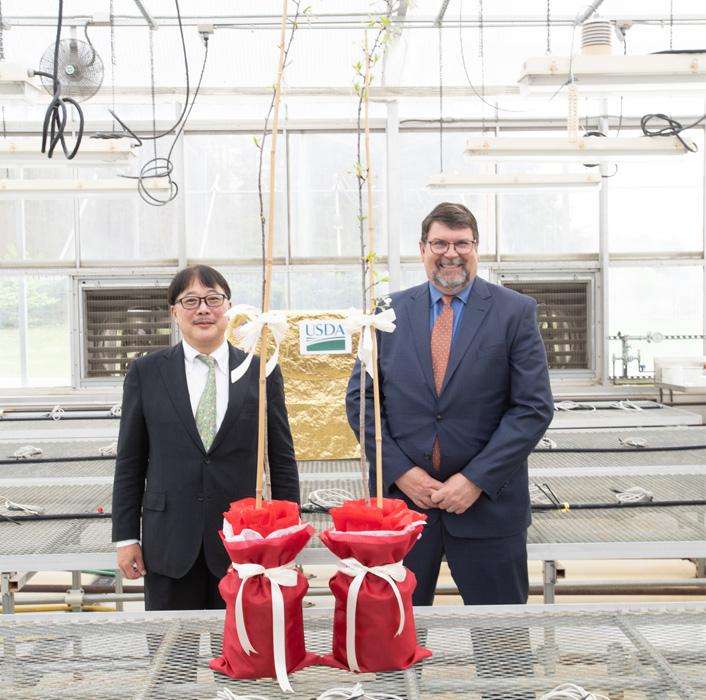
Although PPQ only allows the importation of cherry trees from approved foreign sources due to the risk of plant diseases and plant pests, they issued a Controlled Import Permit which allowed us to safely import the Prime Minister’s gift.
“We transported and safeguarded the cherry trees to the Tidal Basin, and brought them back to the National Plant Germplasm Quarantine Program when the ceremony was over,” said PPQ’s Maryland State Plant Health Director Paul Kanninen. “For the next 24 months, the trees will be here in our quarantine facility. We will test the trees for pathogens and monitor and care for them. Rest assured, they will be strong, healthy, and ready for planting when the time is right.”
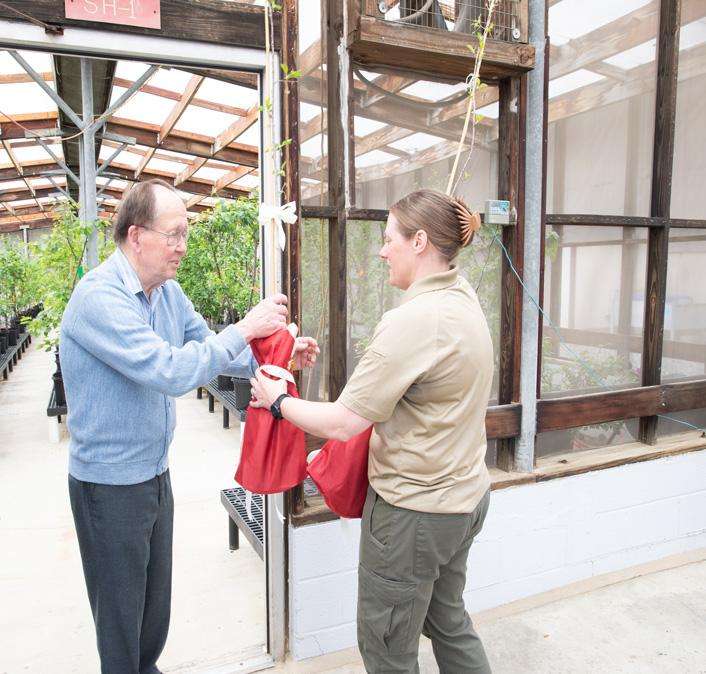
Actions Matter—A Message from the Secretary
The introduction and spread of invasive plant pests and diseases is a national problem that needs a national solution. That’s why every April, USDA promotes Invasive Plant Pest and Disease Awareness Month (IPPDAM) to remind and encourage everyone to learn what they can do to help safeguard the nation’s agricultural and natural resources.
Before you before you bring back a souvenir from a trip, pack up a moving van, mail a package, make an online purchase, or share vegetables from your garden, make sure your actions are safe ones.
In APHIS’ IPPDAM press release, Agriculture Secretary Tom Vilsack provided facts and perspective—“ Annually, invasive insects and plant diseases inflict a staggering $40 billion in damages to plants that we depend on. Invasive species threaten our food supply, agricultural jobs, and way of life. Fortunately, we can reduce their impact and spread.”
To learn more about invasive plant pests and diseases in your area and how to stop them, visit HungryPests.com.

